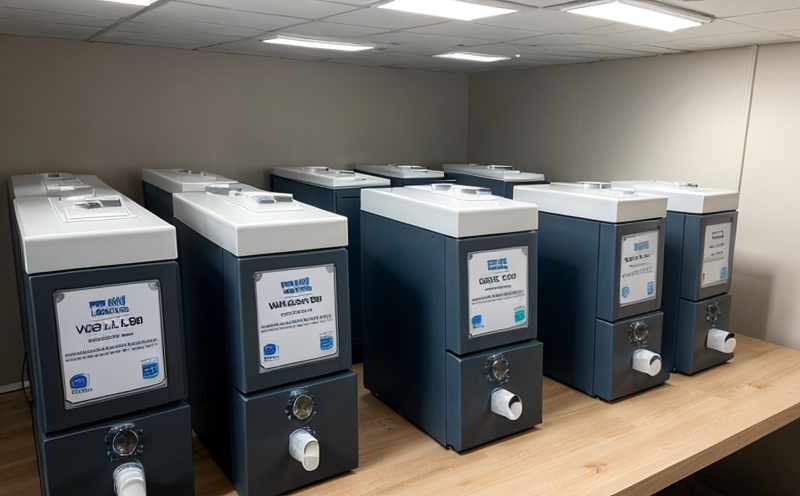VOC chamber test of automotive interior textiles
The Volatile Organic Compound (VOC) chamber test is a crucial method used in ensuring that automotive interior textiles meet stringent environmental and safety standards. This test measures the release of volatile organic compounds from materials used in vehicle interiors, which can have significant implications on human health and indoor air quality.
Formaldehyde, a common VOC found in many household goods including textiles, is known for its irritating effects on mucous membranes and respiratory tract when present at high levels. In automotive interiors, the concentration of formaldehyde must be controlled to meet international standards such as ISO 16000-9 and EN 13322.
The VOC chamber test involves placing textile samples in a sealed chamber for a specified period. During this time, any volatile organic compounds released by the sample are captured and quantified using sophisticated analytical techniques like gas chromatography-mass spectrometry (GC-MS). The measured values provide insights into the potential health risks associated with prolonged exposure to these materials.
Preparing samples correctly is essential for accurate testing. Textiles should be cut to standard sizes, cleaned thoroughly if necessary, and conditioned under specific humidity and temperature conditions before being introduced into the chamber. This ensures that any detected VOCs are genuinely a result of material composition rather than external factors.
The test results play a vital role in product development by helping manufacturers identify problematic materials early on in their supply chain. By understanding which components contribute most to VOC emissions, developers can make informed decisions about substitutes or treatments aimed at reducing harmful compounds.
- Quality Assurance: Ensures consistent performance across all batches of products
- Compliance: Meets regulatory requirements set forth by organizations like the European Union and others globally
The VOC chamber test not only aids in meeting legal standards but also contributes significantly to enhancing brand reputation through responsible manufacturing practices. With increasing awareness about indoor air quality issues, consumers are more likely to choose brands that demonstrate commitment to reducing harmful emissions.
In summary, the VOC chamber test of automotive interior textiles serves multiple purposes: ensuring compliance with international standards, improving product safety, and fostering a healthier environment inside vehicles. It is an indispensable step in the quality control process for any manufacturer aiming to produce safe and sustainable automotive interiors.
Eurolab Advantages
At Eurolab, we pride ourselves on providing comprehensive testing services tailored specifically towards your needs. Our expertise in textile analysis spans across various sectors including automotive, fashion, and home textiles, allowing us to offer specialized solutions for different types of materials.
- Accurate & Reliable Results: Leveraging state-of-the-art equipment and experienced technicians ensures precision in every measurement
- Comprehensive Reporting: Detailed reports outline findings comprehensively, aiding decision-making processes
We understand the importance of timely delivery. Our efficient workflow allows us to turnaround results quickly without compromising on accuracy or detail.
Besides conducting tests ourselves, we also collaborate with leading laboratories worldwide to ensure our clients receive the most up-to-date information and methodologies available. This partnership network helps us stay ahead in terms of compliance requirements and emerging trends within industries like automotive manufacturing.
At Eurolab, your satisfaction is our priority. We offer personalized service options that cater specifically to your business's unique challenges and objectives. Whether you require one-off tests or ongoing monitoring programs, we have the flexibility to accommodate all client needs.
Quality and Reliability Assurance
Evaluation of test reliability involves assessing various aspects such as reproducibility, accuracy, precision, and robustness. Reproducibility ensures consistent results regardless of who performs them; thus, it is crucial for maintaining high standards within the industry.
- Reproducibility: Ensures that tests yield similar results when conducted by different operators
- Precision: Indicates how closely individual measurements agree with each other under identical conditions
To achieve these qualities, Eurolab utilizes advanced analytical instruments and follows strict protocols established according to international standards such as ISO 16000-9. By adhering strictly to these guidelines, we ensure that our results are accurate and reliable.
Moreover, regular calibration of equipment guarantees optimal performance throughout testing periods. This continuous maintenance helps prevent errors caused by worn-out or improperly functioning tools which could lead to inaccurate measurements.
Evaluating precision further involves examining repeatability - the degree to which repeated tests on identical samples produce similar results within a given tolerance range. High levels of reproducibility and precision indicate that our testing procedures are robust enough to withstand variations in environmental factors or operator techniques.
The combination of these elements ensures that every VOC chamber test conducted by Eurolab meets both internal quality control standards as well as external regulatory expectations. This commitment to excellence allows us to deliver trustworthy results, fostering confidence among clients and partners alike.
International Acceptance and Recognition
The importance of international acceptance cannot be overstated in today's globalized market. Many countries have established their own set of regulations regarding VOC emissions from automotive interiors due to growing concerns over indoor air quality and human health impacts. However, adherence to internationally recognized standards offers several advantages.
- Global Consistency: Ensures that products are acceptable across multiple jurisdictions without needing additional testing
- Increased Market Access: Opens doors for exports into regions with stringent regulatory requirements
Countries like the United States, Canada, and various member states of the European Union have implemented their own specific regulations regarding VOC emissions. For instance, the California Air Resources Board (CARB) has established strict limits on formaldehyde release from vehicle interiors under CARB Standard 9-1203.
By aligning our testing protocols with these international standards, Eurolab ensures that its clients' products comply not only locally but also internationally. This alignment helps eliminate discrepancies between local and global regulations, streamlining the export process for manufacturers who wish to penetrate foreign markets.
The acceptance of our test results by various regulatory bodies worldwide adds another layer of credibility to our services. It demonstrates not only our commitment to quality but also reinforces our reputation as a trusted partner in the industry.





